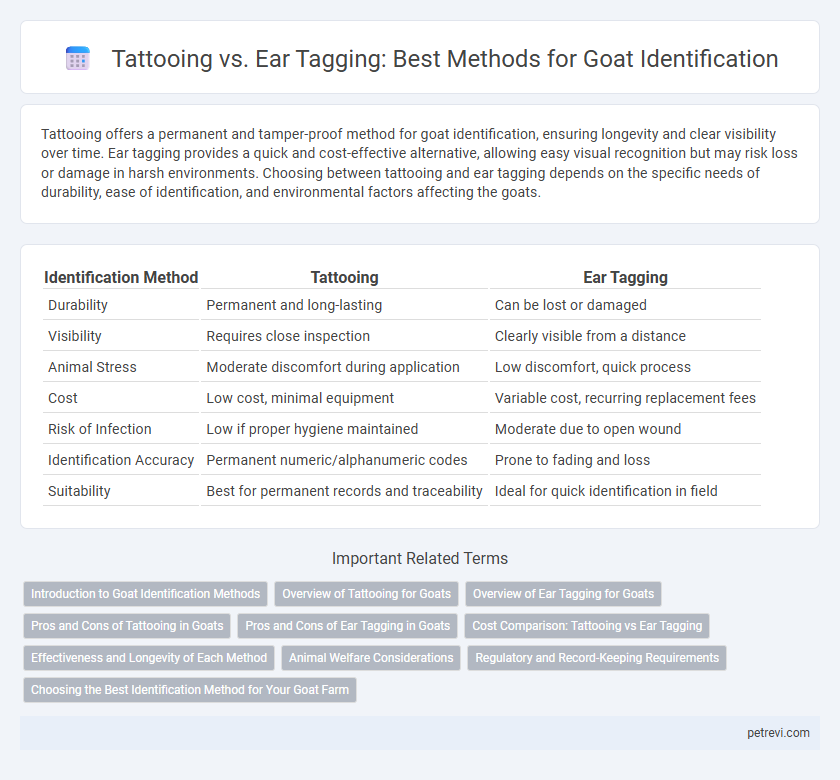Tattooing offers a permanent and tamper-proof method for goat identification, ensuring longevity and clear visibility over time. Ear tagging provides a quick and cost-effective alternative, allowing easy visual recognition but may risk loss or damage in harsh environments. Choosing between tattooing and ear tagging depends on the specific needs of durability, ease of identification, and environmental factors affecting the goats.
Table of Comparison
| Identification Method | Tattooing | Ear Tagging |
|---|---|---|
| Durability | Permanent and long-lasting | Can be lost or damaged |
| Visibility | Requires close inspection | Clearly visible from a distance |
| Animal Stress | Moderate discomfort during application | Low discomfort, quick process |
| Cost | Low cost, minimal equipment | Variable cost, recurring replacement fees |
| Risk of Infection | Low if proper hygiene maintained | Moderate due to open wound |
| Identification Accuracy | Permanent numeric/alphanumeric codes | Prone to fading and loss |
| Suitability | Best for permanent records and traceability | Ideal for quick identification in field |
Introduction to Goat Identification Methods
Goat identification methods primarily include tattooing and ear tagging, each providing unique benefits for livestock management. Tattooing offers a permanent, tamper-resistant mark that remains legible throughout the goat's life, enhancing traceability in breeding and health records. Ear tagging presents a quick and cost-effective alternative, allowing for easy visual identification and electronic tracking through RFID technology.
Overview of Tattooing for Goats
Tattooing for goat identification involves creating permanent markings inside the ear using specialized ink and needles, ensuring lifelong traceability. This method offers durability against weather, wear, and theft, making it reliable for long-term tracking in breeding and health management. Compared to temporary tags, tattooing reduces the risk of loss and exposure to external elements, enhancing identification accuracy in herds.
Overview of Ear Tagging for Goats
Ear tagging is a widely adopted method for goat identification, using durable plastic or metal tags affixed to the goat's ear for easy visual recognition. Tags often include unique alphanumeric codes or barcodes that facilitate efficient record-keeping, herd management, and traceability in livestock operations. This method offers a balance of visibility, cost-effectiveness, and minimal impact on the animal, making it a practical choice in large-scale goat farming.
Pros and Cons of Tattooing in Goats
Tattooing in goats provides a permanent and tamper-resistant identification method, making it highly reliable for long-term tracking and record-keeping. However, it requires skill for proper application and can cause discomfort and stress to the animal during the process. Additionally, visibility of tattoos may diminish over time due to skin changes, potentially complicating identification without proper maintenance.
Pros and Cons of Ear Tagging in Goats
Ear tagging in goats offers a straightforward and cost-effective method for individual identification, allowing easy visual recognition from a distance and facilitating record-keeping in large herds. However, ear tags can suffer from tag loss or damage due to environmental factors or goat behavior, leading to potential misidentification and the need for frequent replacements. This method may also cause discomfort or infection at the tagging site, requiring careful hygiene and monitoring to minimize health risks.
Cost Comparison: Tattooing vs Ear Tagging
Tattooing goats incurs lower long-term costs due to its permanence and lack of replacement needs, despite higher initial labor expenses. Ear tagging involves recurring expenses as tags can be lost or damaged, necessitating frequent replacements and continuous maintenance. Overall, tattooing offers a more cost-effective solution for durable goat identification compared to the ongoing costs associated with ear tagging.
Effectiveness and Longevity of Each Method
Tattooing provides permanent and reliable identification for goats, with ink deposited beneath the skin ensuring longevity unaffected by external wear. Ear tagging offers ease of application and quick visual identification but is prone to loss or damage, reducing its effectiveness over time. Tattooing remains the superior method for long-term traceability in goat management systems.
Animal Welfare Considerations
Tattooing and ear tagging are common methods for goat identification, each with distinct animal welfare implications. Tattooing involves applying permanent ink inside the ear, which can cause short-term pain but minimizes the risk of tag loss or infection compared to ear tagging, where tags puncture the ear tissue and may lead to irritation or injury if not properly managed. Selecting a method that reduces stress and infection risk while ensuring effective identification supports better overall health and welfare for goats.
Regulatory and Record-Keeping Requirements
Tattooing and ear tagging are primary methods for goat identification used to comply with regulatory and record-keeping requirements. Tattooing provides a permanent and tamper-resistant identification that meets many livestock traceability standards, while ear tags offer a visible, easily scannable option for quick identification and data collection. Regulatory bodies often mandate that identification methods allow for accurate herd management, disease control, and traceability, making both tattooing and ear tagging essential tools for maintaining compliance with agricultural regulations.
Choosing the Best Identification Method for Your Goat Farm
Tattooing offers permanent and tamper-proof identification for goats, ensuring clear and lasting marks even in harsh farming conditions. Ear tagging provides a cost-effective and easily visible option, allowing quick individual identification but may suffer from tag loss or damage over time. Selecting the best method depends on farm size, management practices, and the importance of durability versus ease of identification for effective goat tracking and record-keeping.
Tattooing vs Ear Tagging for Goat Identification Infographic

 petrevi.com
petrevi.com